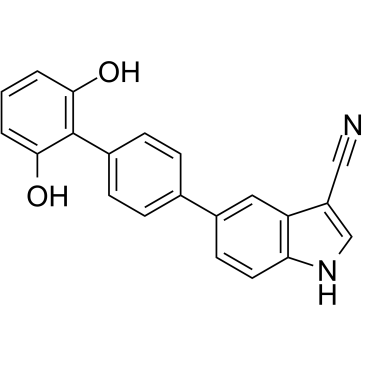MT6378
Modify Date: 2025-09-18 11:13:35

MT6378 structure
|
Common Name | MT6378 | ||
|---|---|---|---|---|
| CAS Number | 1179347-65-9 | Molecular Weight | 326.35 | |
| Density | N/A | Boiling Point | N/A | |
| Molecular Formula | C21H14N2O2 | Melting Point | N/A | |
| MSDS | N/A | Flash Point | N/A | |
Use of MT6378MT 63-78 is a specific and potent direct AMPK activator with an EC50 of 25 μM. MT 63–78 also induces cell mitotic arrest and apoptosis. MT 63-78 blocks prostate cancer growth by inhibiting the lipogenesis and mTORC1 pathways. MT 63-78 has antitumor effects[1]. |
| Name | MT 63-78 |
|---|
| Description | MT 63-78 is a specific and potent direct AMPK activator with an EC50 of 25 μM. MT 63–78 also induces cell mitotic arrest and apoptosis. MT 63-78 blocks prostate cancer growth by inhibiting the lipogenesis and mTORC1 pathways. MT 63-78 has antitumor effects[1]. |
|---|---|
| Related Catalog | |
| Target |
AMPK:25 μM (EC50) mTORC1 |
| In Vitro | MT 63-78 (0-50 μM; 4 days; LNCaP and PC3 cells) treatment shows a dose-dependent decrease in cell number, and concomitant to the activation of AMPK signaling[1]. MT 63-78 (25 μM; 24 hours; LNCaP and CRPC cells) treatment induces a significant enrichement in the G2/M population[1]. MT 63-78 (0-50 μM; 24 hours; LNCaP, PC3, C4-4, C4-2B, CL1and 22RV1cells) treatment induces reduction of anti-apoptotic Mcl-1 in concert with accumulation of the pro-apoptotic BH3-only protein Puma[1]. MT 63-78 (0-50 μM; 30 minutes; LNCaP and PC3 cells) treatment shows a dose-dependent phosphorylation of the two major AMPK targets Acetyl-CoA Carboxylase (ACC) on Ser79 and of Raptor on Ser792. And also increases Thr172 phosphorylation on the AMPK α subunit[1]. Cell Viability Assay[1] Cell Line: LNCaP and PC3 cells Concentration: 0 μM, 1 μM, 5 μM, 10 μM, 25 μM, 50 μM Incubation Time: 4 days Result: A dose-dependent decrease in cell number, concomitant to the activation of AMPK signaling was observed. Cell Cycle Analysis[1] Cell Line: LNCaP and CRPC cells Concentration: 25 μM Incubation Time: 24 hours Result: Induced a significant enrichement in the G2/M population in both androgen sensitive and CRPC cell models. Apoptosis Analysis[1] Cell Line: LNCaP, PC3, C4-4, C4-2B, CL1and 22RV1cells Concentration: 0 μM, 10 μM, 25 μM, 50 μM Incubation Time: 24 hours Result: Induced reduction of anti-apoptotic Mcl-1 in concert with accumulation of the pro-apoptotic BH3-only protein Puma in all PCa cells. Western Blot Analysis[1] Cell Line: LNCaP and PC3 cells Concentration: 0 μM, 0.25 μM, 0.5 μM, 1 μM, 5 μM, 25 μM, 50 μM Incubation Time: 30 minutes Result: Observed a dose-dependent phosphorylation of the two major AMPK targets Acetyl-CoA Carboxylase (ACC) on Ser79 and of Raptor on Ser792. A corresponding increase in Thr172 phosphorylation on the AMPK α subunit was also observed. |
| In Vivo | MT 63-78 (30 mg/kg; intraperitoneal injection; daily; for 14 days; C57 BL/6 male mice) treatment leads to a 33% inhibition of tumor growth[1]. Animal Model: C57 BL/6 male mice bearing LNCaP tumors[1] Dosage: 30 mg/kg Administration: Intraperitoneal injection; daily; for 14 days Result: Led to a 33% inhibition of tumor growth. |
| References |
| Molecular Formula | C21H14N2O2 |
|---|---|
| Molecular Weight | 326.35 |
| InChIKey | IGSYZPLXAFVMKY-UHFFFAOYSA-N |
| SMILES | N#Cc1c[nH]c2ccc(-c3ccc(-c4c(O)cccc4O)cc3)cc12 |